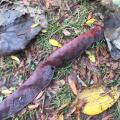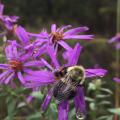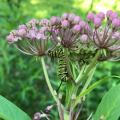October 2017 - Even among all the freshly fallen leaves honey locust (Gleditsia triacanthos) pods stand out on the ground in this young woods. They look like giant, flat pea pods and, unlike the fruit of other native species, nothing eats them. Why would the honey locust tree spend all that energy producing such large fruit if no animal disperses its seeds? The problem may have been answered by an ecologist at the University of Pennsylvania, Dan Janzen, who suggests the honey locust evolved fruit that was eaten by now-extinct megafauna like mastodons.
October 2017 - Eastern wahoo (Euonymus atropurpureus) is setting fruit, which really stands out in the dry woodland as the greens of summer fade. Eastern wahoo is one of the native shrubs we use to replace invasive bush honeysuckle. It's also a host plant for several really cool moths, including the saddleback looper.
New England aster (Symphiotrichum novae-angliae) is one of our late-blooming native plants, and as of early October supplies the dominant color in the Earthwork. The name "New England Aster" is a bit of a misnomer as the plant is indigenous to most of the continental U.S. east of the Rocky Mountains. It is highly valued by pollinators, including this eastern bumble bee.
As of the second week of August we're seeing lots of monarch butterfly eggs and caterpillars, likely members of the fourth and final generation of monarchs for 2017.







